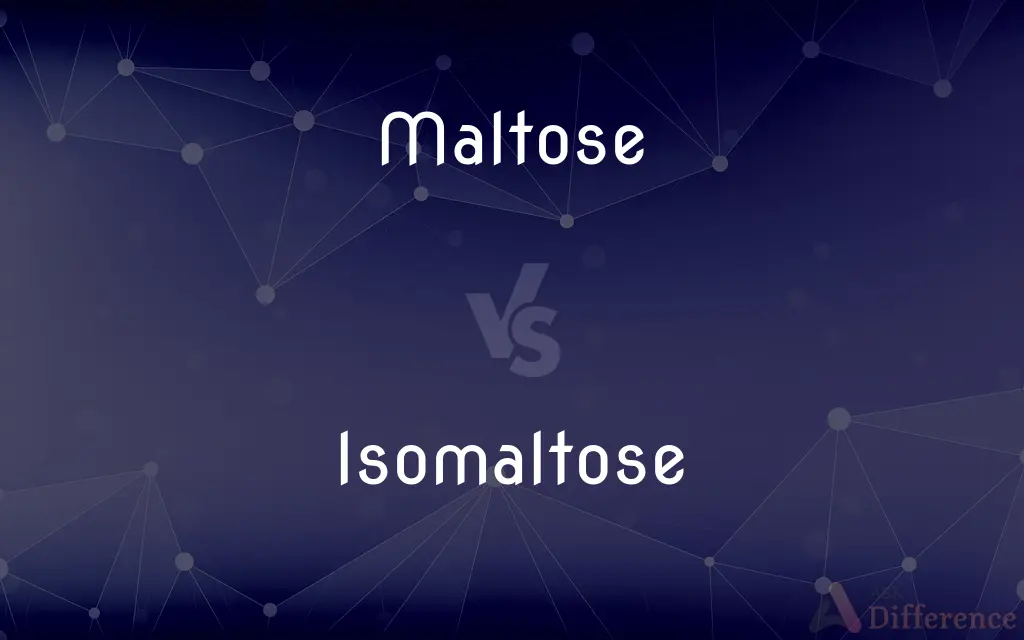Maltose vs. Isomaltose — What's the Difference?
Edited by Tayyaba Rehman — By Urooj Arif — Updated on March 13, 2024
Maltose and isomaltose are both disaccharides, but they differ in their glycosidic linkages; maltose has an α(1→4) bond, while isomaltose has an α(1→6) bond.

Difference Between Maltose and Isomaltose
Table of Contents
ADVERTISEMENT
Key Differences
Maltose, also known as malt sugar, is composed of two glucose molecules connected by an alpha (α) 1→4 glycosidic bond. It is commonly formed during the digestion of starch, particularly in germinating grains and the human digestive system, where enzymes break down starch into simpler sugars. On the other hand, isomaltose is composed of two glucose units as well, but they are linked by an alpha (α) 1→6 glycosidic bond. This difference in linkage results in distinct properties and biological roles for isomaltose, which is less common in nature but can be produced during the breakdown of glycogen and starch by specific enzymes.
The α(1→4) bond in maltose results in a linear structure, allowing it to be easily broken down by the enzyme maltase in the human digestive tract, releasing glucose for absorption and use as energy. Isomaltose, with its α(1→6) linkage, has a slightly branched structure, making it less readily digested by humans as specific enzymes, like isomaltase, are required for its breakdown.
Maltose can be found in various foods, especially those involving the fermentation process, such as beer and malted beverages. It contributes to the flavor profile of these products and is also used in the food industry as a sweetener. Isomaltose, while not as prevalent in the diet, can be present in certain foods and is also used in some industrial processes, particularly those involving the hydrolysis of glycogen and starch.
Both maltose and isomaltose play roles in energy metabolism, but their differing structures and digestive requirements reflect their unique functions and sources in the diet. Despite these differences, both sugars are important in nutrition and biochemistry, each contributing to the body's energy supply and the flavor of foods.
Comparison Chart
Glycosidic Bond
α(1→4)
α(1→6)
ADVERTISEMENT
Composition
Two glucose units
Two glucose units
Common Sources
Germinating grains, fermented products
Hydrolysis of glycogen and starch
Digestive Enzyme
Maltase
Isomaltase
Structure
Linear
Slightly branched
Role in Diet
Energy source, sweetener in foods
Less common, found in certain hydrolyzed foods
Metabolic Process
Easily digested and absorbed, used for energy
Requires specific enzymes for digestion, used for energy
Industrial Use
Used in brewing, food sweeteners
Used in specific hydrolysis processes
Compare with Definitions
Maltose
A disaccharide made of two glucose molecules linked by an α(1→4) bond.
Maltose is produced during the malting process in beer brewing.
Isomaltose
A disaccharide composed of two glucose units linked by an α(1→6) bond.
Isomaltose is a minor product of starch hydrolysis.
Maltose
Broken down by maltase enzyme in the digestive tract.
Maltase in the small intestine efficiently hydrolyzes maltose to glucose.
Isomaltose
Produced during the breakdown of glycogen and starch.
Isomaltose can be generated during the enzymatic processing of starches.
Maltose
Found in germinating grains and products of starch digestion.
Maltose levels increase in grains during the germination process.
Isomaltose
Requires isomaltase for hydrolysis into glucose.
Individuals with isomaltase deficiency may have difficulty digesting isomaltose.
Maltose
Used in the brewing industry and as a food sweetener.
Maltose syrups are used to enhance flavor and texture in confectionery.
Isomaltose
Less prevalent in the diet but contributes to energy metabolism.
Isomaltose, though less common, is part of the pool of sugars utilized for energy.
Maltose
Serves as an important energy source and flavor contributor.
Maltose contributes to the sweet taste of certain breads and beers.
Isomaltose
Utilized in specific enzymatic hydrolysis processes.
Isomaltose may be produced in the industrial hydrolysis of starch for various applications.
Maltose
Maltose ( or ), also known as maltobiose or malt sugar, is a disaccharide formed from two units of glucose joined with an α(1→4) bond. In the isomer isomaltose, the two glucose molecules are joined with an α(1→6) bond.
Isomaltose
Isomaltose is a disaccharide similar to maltose, but with a α-(1-6)-linkage instead of the α-(1-4)-linkage. Both of the sugars are glucose, which is a pyranose sugar.
Maltose
A sugar produced by the breakdown of starch, e.g. by enzymes found in malt and saliva. It is a disaccharide consisting of two linked glucose units.
Isomaltose
(carbohydrate) An isomer of maltose (linked α1-6 rather than α1-4); brachyose
Maltose
A white disaccharide, C12H22O11, formed during the digestion of starch. Also called malt sugar.
Maltose
(carbohydrate) A disaccharide, C12H22O11 formed from the digestion of starch by amylase; is converted to glucose by maltase; it is an isomer of trehalose
Maltose
A crystalline disaccharide (C12H22O11) formed from starch by the action of diastase of malt, and the amylolytic ferment of saliva and pancreatic juice; called also maltobiose and malt sugar. Chemically it is 4-O-
Maltose
A white crystalline sugar formed during the digestion of starches
Common Curiosities
What is the main structural difference between maltose and isomaltose?
The main difference is the type of glycosidic bond: maltose has an α(1→4) bond, while isomaltose has an α(1→6) bond.
Do maltose and isomaltose have the same caloric value?
Yes, both provide similar caloric value as they are both composed of two glucose units.
Can both maltose and isomaltose be found in our diet?
Yes, both can be part of the diet, but maltose is more common due to its presence in fermented products and as a result of starch digestion.
Why is maltose easier to digest than isomaltose for most people?
Maltose is more easily digested due to the widespread presence and activity of maltase in the human digestive system, compared to the specific enzyme required for isomaltose.
Are there any health concerns associated with consuming maltose or isomaltose?
In general, consumption as part of a balanced diet is not a concern, but excessive intake of sugars, including maltose and isomaltose, should be avoided to maintain overall health.
Can maltose and isomaltose be used as sweeteners?
Maltose is commonly used as a sweetener in various food products due to its moderate sweetness. Isomaltose, while less sweet and less common, can also be used as a sweetener in specialized applications.
Are there any specific health benefits associated with maltose or isomaltose?
Neither maltose nor isomaltose is known for specific health benefits. Like other sugars, they should be consumed in moderation within a balanced diet.
How are maltose and isomaltose produced industrially?
Maltose is often produced by the enzymatic hydrolysis of starch from grains, particularly during malting and brewing processes. Isomaltose is less commonly produced but can be obtained through specific enzymatic reactions on starch or glycogen.
What is the significance of maltose and isomaltose in plant biology?
Maltose is significant in plant biology as a product of starch degradation, particularly during seed germination, where it serves as an energy source. Isomaltose may also play a role in the metabolism of some plants, although its function is less well-understood compared to maltose.
What role do maltose and isomaltose play in fermentation processes?
Maltose serves as an important fermentable sugar in brewing and baking, where it is metabolized by yeast to produce alcohol and carbon dioxide. Isomaltose can also be fermented by certain microorganisms, though it is less commonly involved in fermentation processes.
How do the glycosidic bonds in maltose and isomaltose affect their chemical properties?
The glycosidic bonds (α(1→4) in maltose and α(1→6) in isomaltose) influence their digestibility, solubility, and reactivity, contributing to their unique roles in biological systems and food science.
Can maltose or isomaltose cause allergic reactions?
True allergic reactions to specific sugars like maltose and isomaltose are extremely rare. However, individuals may have sensitivities or intolerances to certain sugars that can cause digestive discomfort.
How do maltose and isomaltose impact the flavor of food?
Maltose adds a mild sweetness and is often associated with the characteristic flavor of malted foods and beverages. Isomaltose's impact on flavor is less pronounced due to its lower sweetness and prevalence.
Are maltose and isomaltose considered reducing sugars?
Yes, both maltose and isomaltose are considered reducing sugars, meaning they have a free aldehyde or ketone group capable of acting as a reducing agent.
Share Your Discovery

Previous Comparison
Telescope vs. Diopter
Next Comparison
Polyurethane vs. NeopreneAuthor Spotlight
Written by
Urooj ArifUrooj is a skilled content writer at Ask Difference, known for her exceptional ability to simplify complex topics into engaging and informative content. With a passion for research and a flair for clear, concise writing, she consistently delivers articles that resonate with our diverse audience.
Edited by
Tayyaba RehmanTayyaba Rehman is a distinguished writer, currently serving as a primary contributor to askdifference.com. As a researcher in semantics and etymology, Tayyaba's passion for the complexity of languages and their distinctions has found a perfect home on the platform. Tayyaba delves into the intricacies of language, distinguishing between commonly confused words and phrases, thereby providing clarity for readers worldwide.
















































